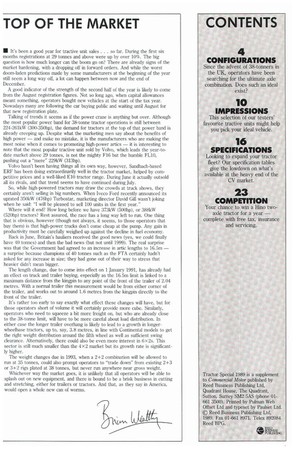TOP OF THE MARKET
Page 95

If you've noticed an error in this article please click here to report it so we can fix it.
• It's been a good year for tractive unit sales. . so far. During the first six months registrations at 29 tonnes and above were up by over 10%. The big question is how much longer can the boom go on? There are already signs of the market hardening, with a dropping off in forward orders. And while the worst doom-laden predictions made by some manufacturers at the beginning of the year still seem a long way off, a lot can happen between now and the end of December.
A good indicator of the strength of the second half of the year is likely to come from the August registration figures. Not so long ago, when capital allowances meant something, operators bought new vehicles at the start of the tax year. Nowadays many are following the car buying public and waiting until August for that new registration plate.
Talking of trends it seems as if the power craze is anything but over. Although the most popular power band for 38-tonne tractor operations is still between 224-261kW (300-350hp), the demand for tractors at the top of that power band is already creeping up. Despite what the marketing men say about the benefits of high power — and make no mistake, it is the manufacturers who are making the most noise when it comes to promoting high-power attics — it is interesting to note that the most popular tractive unit sold by Volvo, which leads the year-todate market above 29 tonnes, is not the mighty F16 hut the humble FL10, pushing out a "mere" 229kW (313hp).
Volvo hasn't been having things all its own way, however, Sandbach-based ERF has been doing extraordinarily well in the tractor market, helped by competitive prices and a well-liked E10 tractor range. During June it actually outsold all its rivals, and that trend seems to have continued during July.
So, while high-powered tractors may draw the crowds at truck shows, they certainly aren't selling in big numbers. When Iveco Ford recently announced its uprated 350kVY' (476hp) Turbostar, marketing director David Gill wasn't joking when he said: "I will be pleased to sell 100 units in the first year."
Where will it end? How long before we have 373kW (500hp), or 388kW (520hp) tractors? Rest assured, the race has a long way left to run. One thing that is obvious, however (though not always, it seems, to those operators that buy them) is that high-power trucks don't come cheap at the pump. Any gain in productivity must be carefully weighed up against the decline in fuel economy.
Back in June, Britain's hauliers received the good news (yes, we could finally have 40 tonnes) and then the bad news (but not until 1999). The real surprise was that the Government had agreed to an increase in attic lengths to 16.5m — a surprise because champions of 40 tonnes such as the FTA certainly hadn't asked for any increase in size; they had gone out of their way to stress that heavier didn't mean bigger.
The length change, due to come into effect on 1 January 1991, has already had an effect on truck and trailer buying, especially as the 16.5m limit is linked to a maximum distance from the kingpin to any point of the front of the trailer of 2.04 metres. With a normal trailer this measurement would be from either corner of the trailer, and works out to around 1.6 metres from the kingpin directly to the front of the trailer.
It's rather too early to say exactly what effect these changes will have, but for those operators short of volume it will certainly provide more cube. Similarly, operators who need to squeeze a bit more freight on, but who are already close to the 38-tonne limit, will have to be more careful about load distribution. In either case the longer trailer overhang is likely to lead to a growth in longerwheelbase tractors, up to, say, 3.8 metres, in Line with Continental models to get the right weight distribution around the fifth wheel as well as sufficient swing clearance. Alternatively, there could also be even more interest in 6x 2s. This sector is still much smaller than the 4x2 market but its growth rate is significantly higher.
The weight changes due in 1993, when a 2+2 combination will be allowed to run at 35 tonnes, could also prompt operators to "trade down" from existing 2+3 or 3+2 rigs plated at 38 tonnes, but never run anywhere near gross weight.
Whichever way the market goes, it is unlikely that all operators will be able to splash out on new equipment, and there is bound to be a brisk business in cutting and stretching, either for trailers or tractors. And that, as they say in America, would open a whole new can of worms.


































































































































